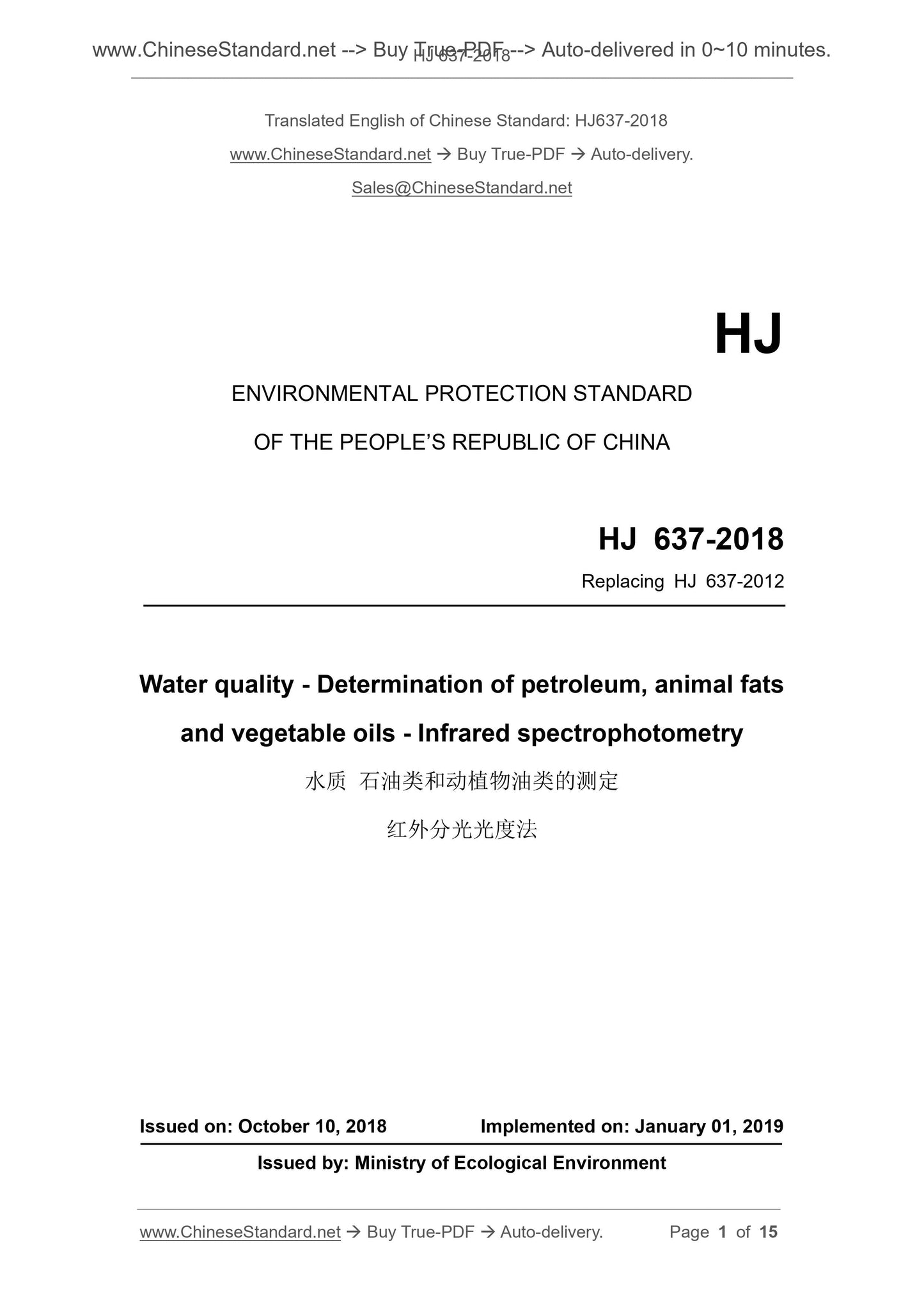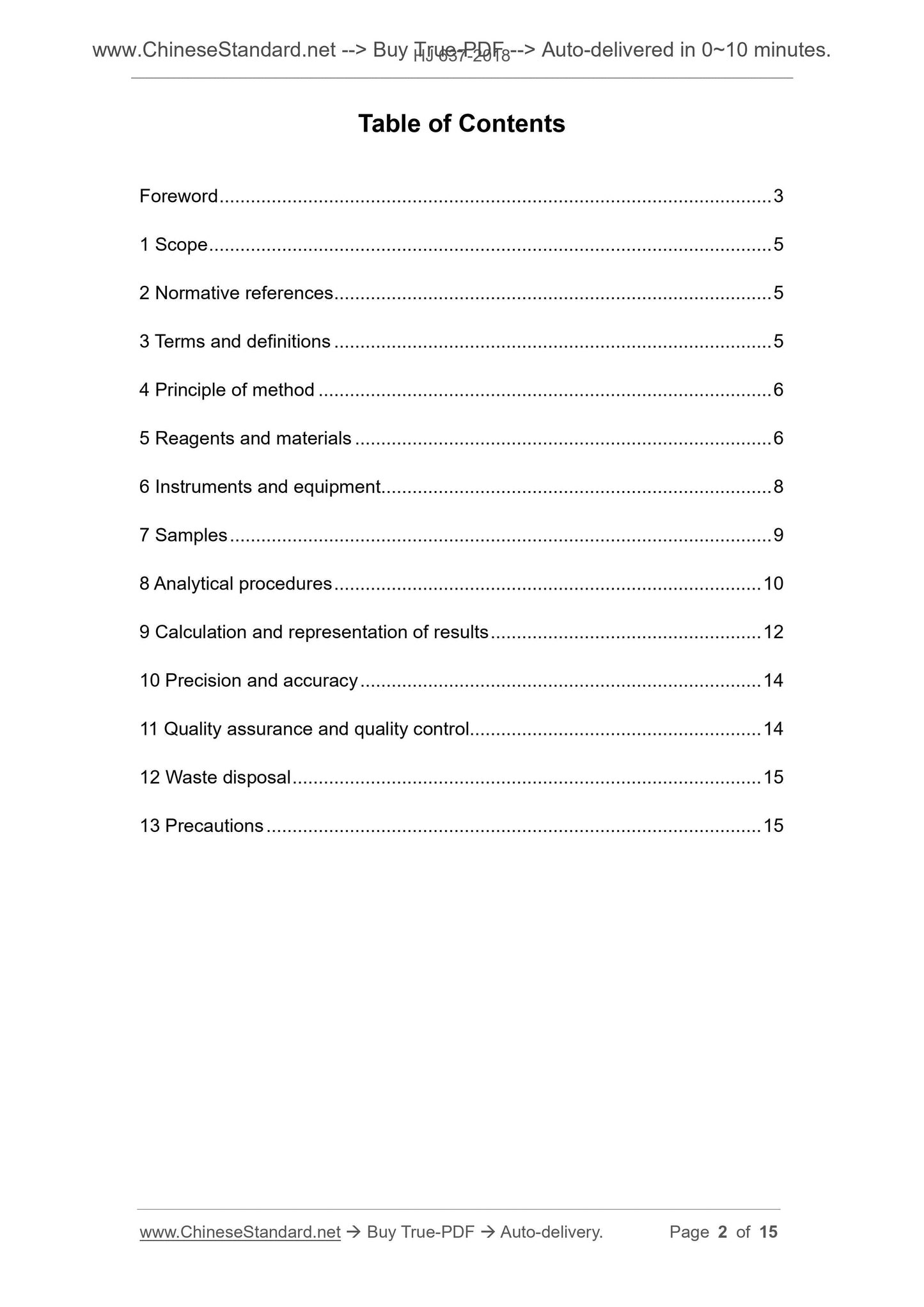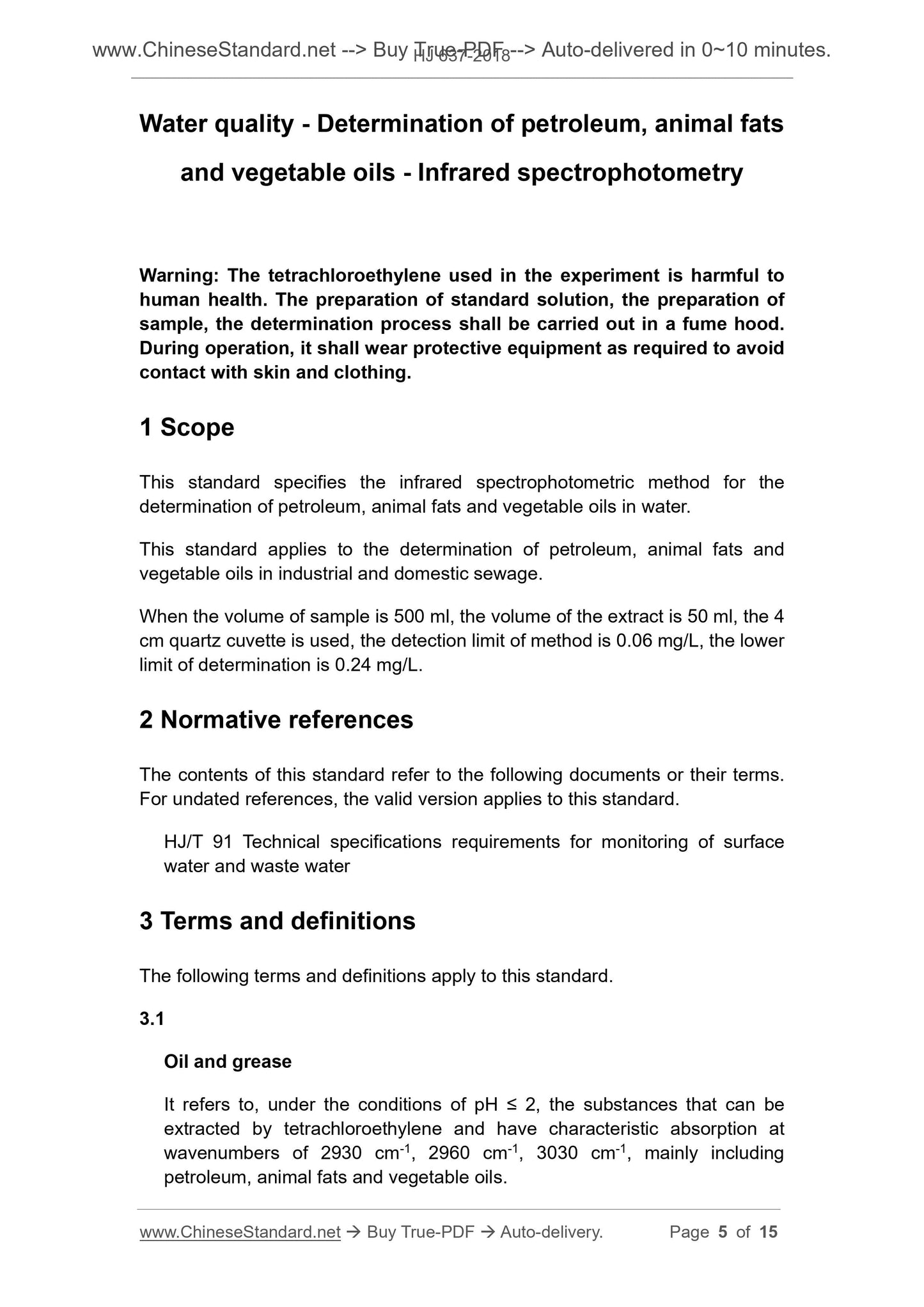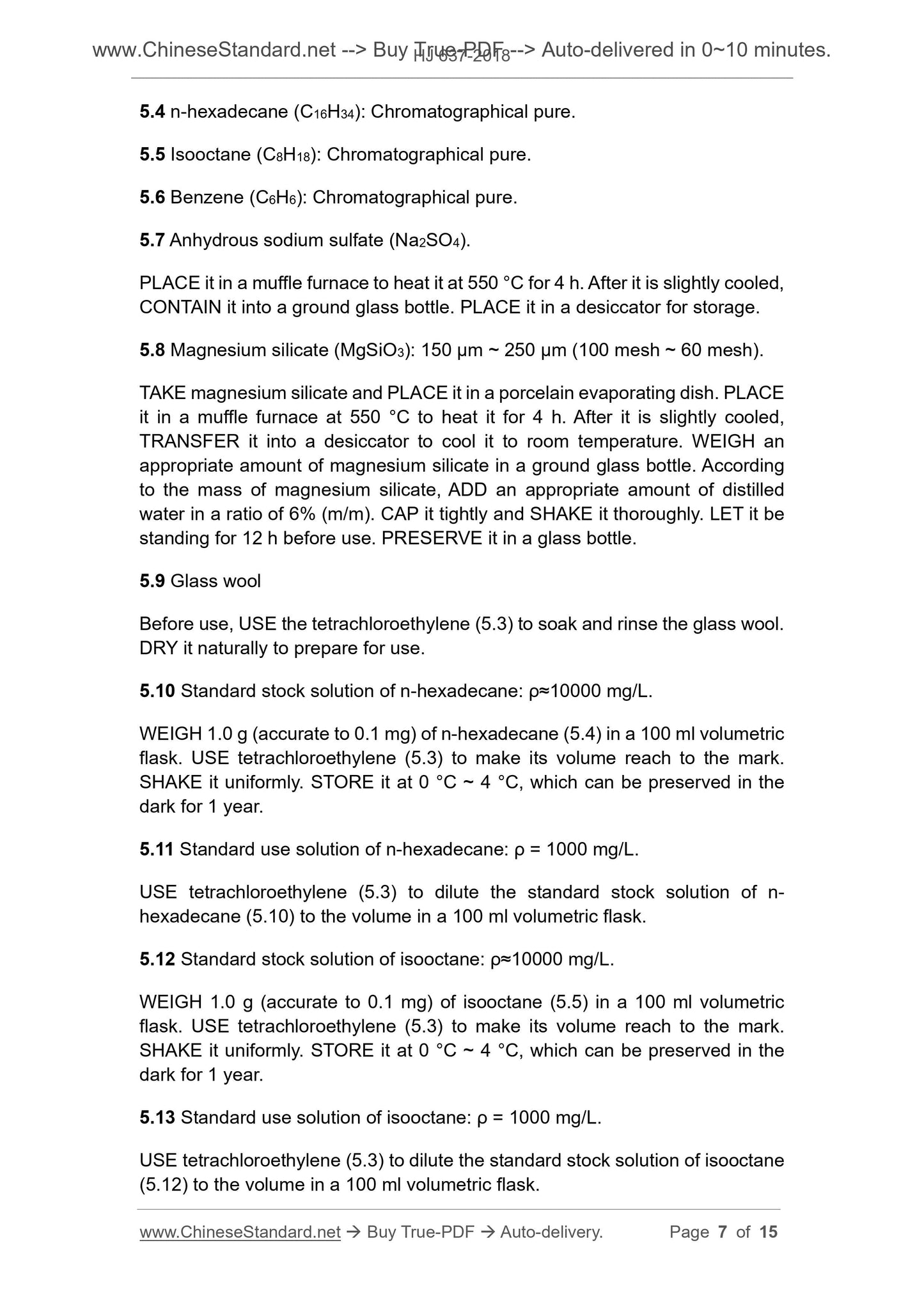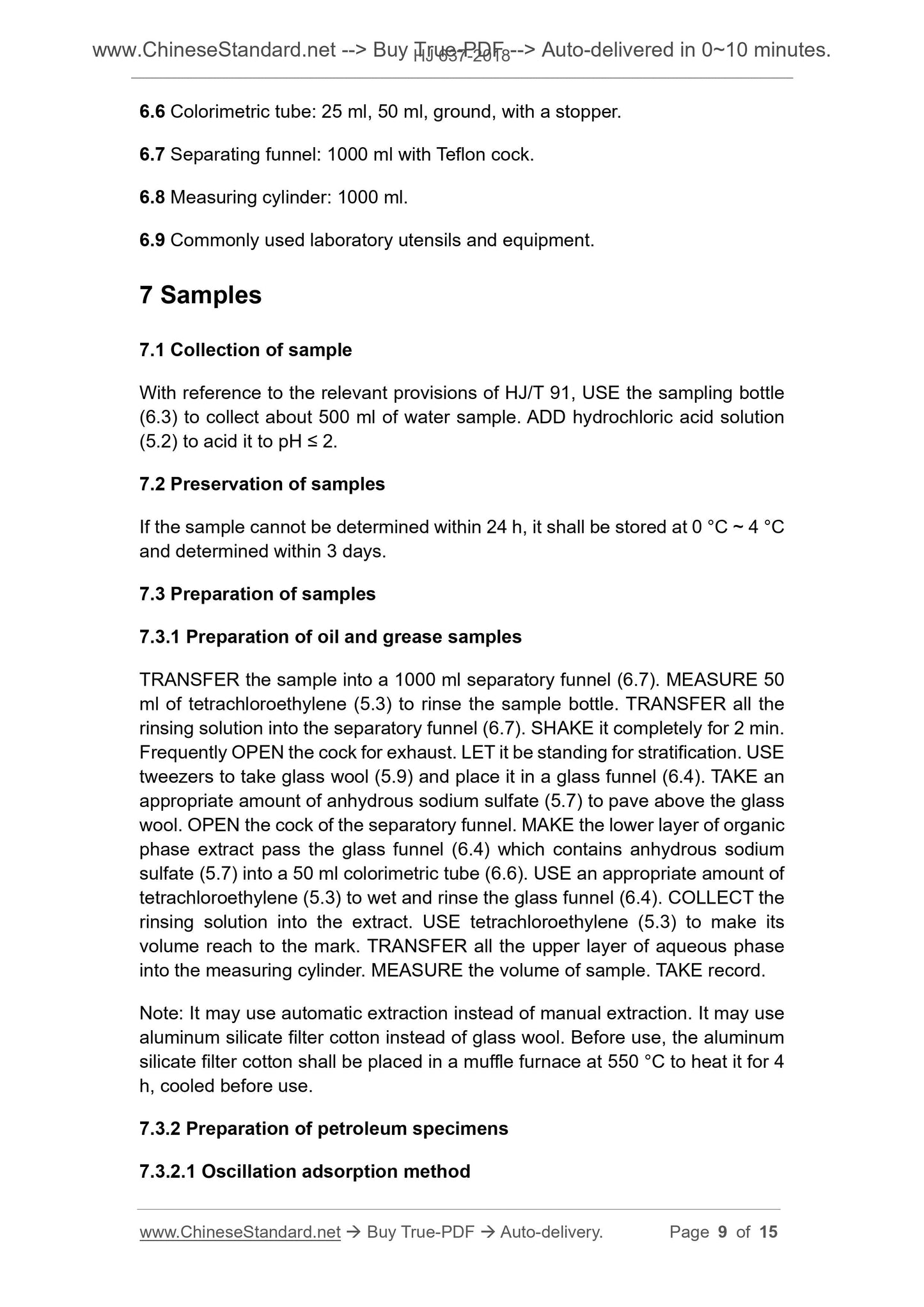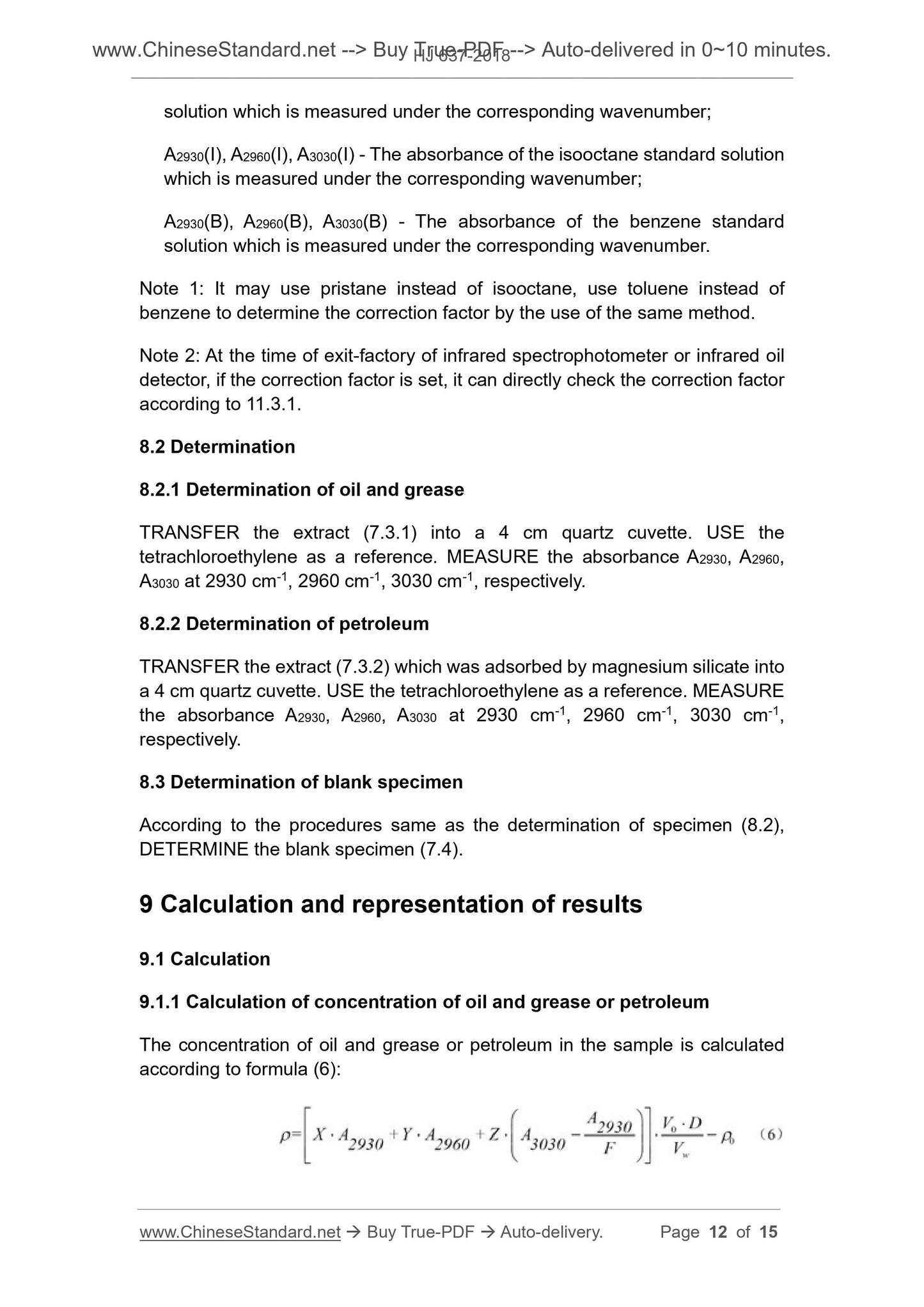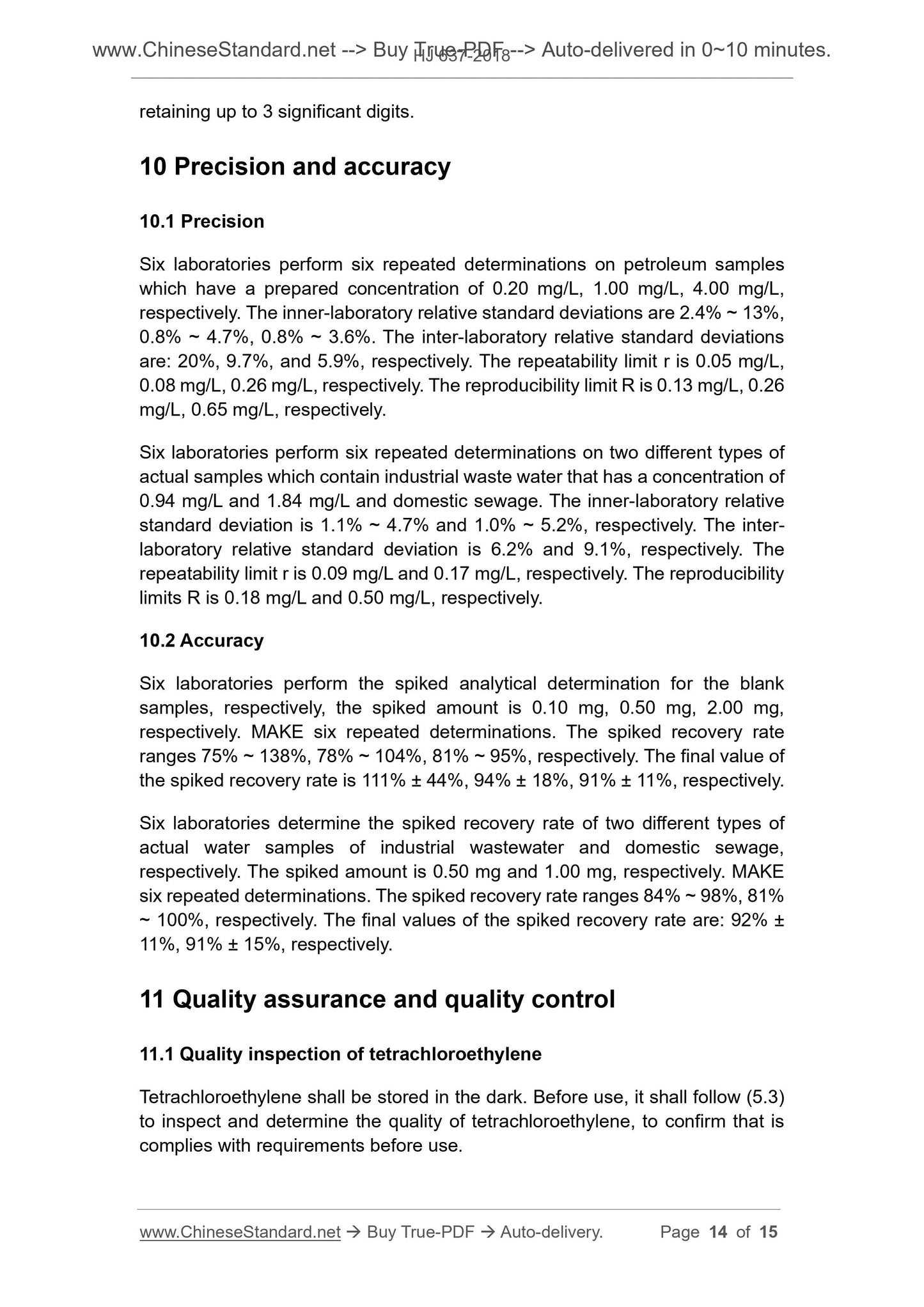1
/
of
7
PayPal, credit cards. Download editable-PDF and invoice in 1 second!
HJ 637-2018 English PDF (HJ637-2018)
HJ 637-2018 English PDF (HJ637-2018)
Regular price
$210.00 USD
Regular price
Sale price
$210.00 USD
Unit price
/
per
Shipping calculated at checkout.
Couldn't load pickup availability
Delivery: 3 seconds. Download true-PDF + Invoice.
Get QUOTATION in 1-minute: Click HJ 637-2018
Historical versions: HJ 637-2018
Preview True-PDF (Reload/Scroll if blank)
HJ 637-2018: Water quality - Determination of petroleum, animal fats and vegetable oils - Infrared spectrophotometry
HJ 637-2018
HJ
ENVIRONMENTAL PROTECTION STANDARD
OF THE PEOPLE’S REPUBLIC OF CHINA
Replacing HJ 637-2012
Water quality - Determination of petroleum, animal fats
and vegetable oils - Infrared spectrophotometry
ISSUED ON. OCTOBER 10, 2018
IMPLEMENTED ON. JANUARY 01, 2019
Issued by. Ministry of Ecological Environment
Table of Contents
Foreword ... 3
1 Scope ... 5
2 Normative references ... 5
3 Terms and definitions ... 5
4 Principle of method ... 6
5 Reagents and materials ... 6
6 Instruments and equipment... 8
7 Samples ... 9
8 Analytical procedures ... 10
9 Calculation and representation of results ... 12
10 Precision and accuracy ... 14
11 Quality assurance and quality control... 14
12 Waste disposal ... 15
13 Precautions ... 15
Water quality - Determination of petroleum, animal fats
and vegetable oils - Infrared spectrophotometry
Warning. The tetrachloroethylene used in the experiment is harmful to
human health. The preparation of standard solution, the preparation of
sample, the determination process shall be carried out in a fume hood.
During operation, it shall wear protective equipment as required to avoid
contact with skin and clothing.
1 Scope
This standard specifies the infrared spectrophotometric method for the
determination of petroleum, animal fats and vegetable oils in water.
This standard applies to the determination of petroleum, animal fats and
vegetable oils in industrial and domestic sewage.
When the volume of sample is 500 ml, the volume of the extract is 50 ml, the 4
cm quartz cuvette is used, the detection limit of method is 0.06 mg/L, the lower
limit of determination is 0.24 mg/L.
2 Normative references
The contents of this standard refer to the following documents or their terms.
For undated references, the valid version applies to this standard.
HJ/T 91 Technical specifications requirements for monitoring of surface
water and waste water
3 Terms and definitions
The following terms and definitions apply to this standard.
3.1
Oil and grease
It refers to, under the conditions of pH ≤ 2, the substances that can be
extracted by tetrachloroethylene and have characteristic absorption at
wavenumbers of 2930 cm-1, 2960 cm-1, 3030 cm-1, mainly including
petroleum, animal fats and vegetable oils.
5.4 n-hexadecane (C16H34). Chromatographical pure.
5.5 Isooctane (C8H18). Chromatographical pure.
5.6 Benzene (C6H6). Chromatographical pure.
5.7 Anhydrous sodium sulfate (Na2SO4).
PLACE it in a muffle furnace to heat it at 550 °C for 4 h. After it is slightly cooled,
CONTAIN it into a ground glass bottle. PLACE it in a desiccator for storage.
5.8 Magnesium silicate (MgSiO3). 150 μm ~ 250 μm (100 mesh ~ 60 mesh).
TAKE magnesium silicate and PLACE it in a porcelain evaporating dish. PLACE
it in a muffle furnace at 550 °C to heat it for 4 h. After it is slightly cooled,
TRANSFER it into a desiccator to cool it to room temperature. WEIGH an
appropriate amount of magnesium silicate in a ground glass bottle. According
to the mass of magnesium silicate, ADD an appropriate amount of distilled
water in a ratio of 6% (m/m). CAP it tightly and SHAKE it thoroughly. LET it be
standing for 12 h before use. PRESERVE it in a glass bottle.
5.9 Glass wool
Before use, USE the tetrachloroethylene (5.3) to soak and rinse the glass wool.
DRY it naturally to prepare for use.
5.10 Standard stock solution of n-hexadecane. ρ≈10000 mg/L.
WEIGH 1.0 g (accurate to 0.1 mg) of n-hexadecane (5.4) in a 100 ml volumetric
flask. USE tetrachloroethylene (5.3) to make its volume reach to the mark.
SHAKE it uniformly. STORE it at 0 °C ~ 4 °C, which can be preserved in the
dark for 1 year.
5.11 Standard use solution of n-hexadecane. ρ = 1000 mg/L.
USE tetrachloroethylene (5.3) to dilute the standard stock solution of n-
hexadecane (5.10) to the volume in a 100 ml volumetric flask.
5.12 Standard stock solution of isooctane. ρ≈10000 mg/L.
WEIGH 1.0 g (accurate to 0.1 mg) of isooctane (5.5) in a 100 ml volumetric
flask. USE tetrachloroethylene (5.3) to make its volume reach to the mark.
SHAKE it uniformly. STORE it at 0 °C ~ 4 °C, which can be preserved in the
dark for 1 year.
5.13 Standard use solution of isooctane. ρ = 1000 mg/L.
USE tetrachloroethylene (5.3) to dilute the standard stock solution of isooctane
(5.12) to the volume in a 100 ml volumetric flask.
6.6 Colorimetric tube. 25 ml, 50 ml, ground, with a stopper.
6.7 Separating funnel. 1000 ml with Teflon cock.
6.8 Measuring cylinder. 1000 ml.
6.9 Commonly used laboratory utensils and equipment.
7 Samples
7.1 Collection of sample
With reference to the relevant provisions of HJ/T 91, USE the sampling bottle
(6.3) to collect about 500 ml of water sample. ADD hydrochloric acid solution
(5.2) to acid it to pH ≤ 2.
7.2 Preservation of samples
If the sample cannot be determined within 24 h, it shall be stored at 0 °C ~ 4 °C
and determined within 3 days.
7.3 Preparation of samples
7.3.1 Preparation of oil and grease samples
TRANSFER the sample into a 1000 ml separatory funnel (6.7). MEASURE 50
ml of tetrachloroethylene (5.3) to rinse the sample bottle. TRANSFER all the
rinsing solution into the separatory funnel (6.7). SHAKE it completely for 2 min.
Frequently OPEN the cock for exhaust. LET it be standing for stratification. USE
tweezers to take glass wool (5.9) and place it in a glass funnel (6.4). TAKE an
appropriate amount of anhydrous sodium sulfate (5.7) to pave above the glass
wool. OPEN the cock of the separatory funnel. MAKE the lower layer of organic
phase extract pass the glass funnel (6.4) which contains anhydrous sodium
sulfate (5.7) into a 50 ml colorimetric tube (6.6). USE an appropriate amount of
tetrachloroethylene (5.3) to wet and rinse the glass funnel (6.4). COLLECT the
rinsing solution into the extract. USE tetrachloroethylene (5.3) to make its
volume reach to the mark. TRANSFER all the upper layer of aqueous phase
into the measuring cylinder. MEASURE the volume of sample. TAKE record.
Note. It may use automatic extraction instead of manual extraction. It may use
aluminum silicate filter cotton instead of glass wool. Before use, the aluminum
silicate filter cotton shall be placed in a muffle furnace at 550 °C to heat it for 4
h, cooled before use.
7.3.2 Preparation of petroleum specimens
7.3.2.1 Oscillation adsorption method
solution which is measured under the corresponding wavenumber;
A2930(I), A2960(I), A3030(I) - The absorbance of the isooctane standard solution
which is measured under the corresponding wavenumber;
A2930(B), A2960(B), A3030(B) - The absorbance of the benzene standard
solution which is measured under the corresponding wavenumber.
Note 1. It may use pristane instead of isooctane, use toluene instead of
benzene to determine the correction factor by the use of the same method.
Note 2. At the time of exit-factory of infrared spectrophotometer or infrared oil
detector, if the correction factor is set, it can directly check the correction factor
according to 11.3.1.
8.2 Determination
8.2.1 Determination of oil and grease
TRANSFER the extract (7.3.1) into a 4 cm quartz cuvette. USE the
tetrachloroethylene as a reference. MEASURE the absorbance A2930, A2960,
A3030 at 2930 cm-1, 2960 cm-1, 3030 cm-1, respectively.
8.2.2 Determination of petroleum
TRANSFER the extract (7.3.2) which was adsorbed by magnesium silicate into
a ...
Get QUOTATION in 1-minute: Click HJ 637-2018
Historical versions: HJ 637-2018
Preview True-PDF (Reload/Scroll if blank)
HJ 637-2018: Water quality - Determination of petroleum, animal fats and vegetable oils - Infrared spectrophotometry
HJ 637-2018
HJ
ENVIRONMENTAL PROTECTION STANDARD
OF THE PEOPLE’S REPUBLIC OF CHINA
Replacing HJ 637-2012
Water quality - Determination of petroleum, animal fats
and vegetable oils - Infrared spectrophotometry
ISSUED ON. OCTOBER 10, 2018
IMPLEMENTED ON. JANUARY 01, 2019
Issued by. Ministry of Ecological Environment
Table of Contents
Foreword ... 3
1 Scope ... 5
2 Normative references ... 5
3 Terms and definitions ... 5
4 Principle of method ... 6
5 Reagents and materials ... 6
6 Instruments and equipment... 8
7 Samples ... 9
8 Analytical procedures ... 10
9 Calculation and representation of results ... 12
10 Precision and accuracy ... 14
11 Quality assurance and quality control... 14
12 Waste disposal ... 15
13 Precautions ... 15
Water quality - Determination of petroleum, animal fats
and vegetable oils - Infrared spectrophotometry
Warning. The tetrachloroethylene used in the experiment is harmful to
human health. The preparation of standard solution, the preparation of
sample, the determination process shall be carried out in a fume hood.
During operation, it shall wear protective equipment as required to avoid
contact with skin and clothing.
1 Scope
This standard specifies the infrared spectrophotometric method for the
determination of petroleum, animal fats and vegetable oils in water.
This standard applies to the determination of petroleum, animal fats and
vegetable oils in industrial and domestic sewage.
When the volume of sample is 500 ml, the volume of the extract is 50 ml, the 4
cm quartz cuvette is used, the detection limit of method is 0.06 mg/L, the lower
limit of determination is 0.24 mg/L.
2 Normative references
The contents of this standard refer to the following documents or their terms.
For undated references, the valid version applies to this standard.
HJ/T 91 Technical specifications requirements for monitoring of surface
water and waste water
3 Terms and definitions
The following terms and definitions apply to this standard.
3.1
Oil and grease
It refers to, under the conditions of pH ≤ 2, the substances that can be
extracted by tetrachloroethylene and have characteristic absorption at
wavenumbers of 2930 cm-1, 2960 cm-1, 3030 cm-1, mainly including
petroleum, animal fats and vegetable oils.
5.4 n-hexadecane (C16H34). Chromatographical pure.
5.5 Isooctane (C8H18). Chromatographical pure.
5.6 Benzene (C6H6). Chromatographical pure.
5.7 Anhydrous sodium sulfate (Na2SO4).
PLACE it in a muffle furnace to heat it at 550 °C for 4 h. After it is slightly cooled,
CONTAIN it into a ground glass bottle. PLACE it in a desiccator for storage.
5.8 Magnesium silicate (MgSiO3). 150 μm ~ 250 μm (100 mesh ~ 60 mesh).
TAKE magnesium silicate and PLACE it in a porcelain evaporating dish. PLACE
it in a muffle furnace at 550 °C to heat it for 4 h. After it is slightly cooled,
TRANSFER it into a desiccator to cool it to room temperature. WEIGH an
appropriate amount of magnesium silicate in a ground glass bottle. According
to the mass of magnesium silicate, ADD an appropriate amount of distilled
water in a ratio of 6% (m/m). CAP it tightly and SHAKE it thoroughly. LET it be
standing for 12 h before use. PRESERVE it in a glass bottle.
5.9 Glass wool
Before use, USE the tetrachloroethylene (5.3) to soak and rinse the glass wool.
DRY it naturally to prepare for use.
5.10 Standard stock solution of n-hexadecane. ρ≈10000 mg/L.
WEIGH 1.0 g (accurate to 0.1 mg) of n-hexadecane (5.4) in a 100 ml volumetric
flask. USE tetrachloroethylene (5.3) to make its volume reach to the mark.
SHAKE it uniformly. STORE it at 0 °C ~ 4 °C, which can be preserved in the
dark for 1 year.
5.11 Standard use solution of n-hexadecane. ρ = 1000 mg/L.
USE tetrachloroethylene (5.3) to dilute the standard stock solution of n-
hexadecane (5.10) to the volume in a 100 ml volumetric flask.
5.12 Standard stock solution of isooctane. ρ≈10000 mg/L.
WEIGH 1.0 g (accurate to 0.1 mg) of isooctane (5.5) in a 100 ml volumetric
flask. USE tetrachloroethylene (5.3) to make its volume reach to the mark.
SHAKE it uniformly. STORE it at 0 °C ~ 4 °C, which can be preserved in the
dark for 1 year.
5.13 Standard use solution of isooctane. ρ = 1000 mg/L.
USE tetrachloroethylene (5.3) to dilute the standard stock solution of isooctane
(5.12) to the volume in a 100 ml volumetric flask.
6.6 Colorimetric tube. 25 ml, 50 ml, ground, with a stopper.
6.7 Separating funnel. 1000 ml with Teflon cock.
6.8 Measuring cylinder. 1000 ml.
6.9 Commonly used laboratory utensils and equipment.
7 Samples
7.1 Collection of sample
With reference to the relevant provisions of HJ/T 91, USE the sampling bottle
(6.3) to collect about 500 ml of water sample. ADD hydrochloric acid solution
(5.2) to acid it to pH ≤ 2.
7.2 Preservation of samples
If the sample cannot be determined within 24 h, it shall be stored at 0 °C ~ 4 °C
and determined within 3 days.
7.3 Preparation of samples
7.3.1 Preparation of oil and grease samples
TRANSFER the sample into a 1000 ml separatory funnel (6.7). MEASURE 50
ml of tetrachloroethylene (5.3) to rinse the sample bottle. TRANSFER all the
rinsing solution into the separatory funnel (6.7). SHAKE it completely for 2 min.
Frequently OPEN the cock for exhaust. LET it be standing for stratification. USE
tweezers to take glass wool (5.9) and place it in a glass funnel (6.4). TAKE an
appropriate amount of anhydrous sodium sulfate (5.7) to pave above the glass
wool. OPEN the cock of the separatory funnel. MAKE the lower layer of organic
phase extract pass the glass funnel (6.4) which contains anhydrous sodium
sulfate (5.7) into a 50 ml colorimetric tube (6.6). USE an appropriate amount of
tetrachloroethylene (5.3) to wet and rinse the glass funnel (6.4). COLLECT the
rinsing solution into the extract. USE tetrachloroethylene (5.3) to make its
volume reach to the mark. TRANSFER all the upper layer of aqueous phase
into the measuring cylinder. MEASURE the volume of sample. TAKE record.
Note. It may use automatic extraction instead of manual extraction. It may use
aluminum silicate filter cotton instead of glass wool. Before use, the aluminum
silicate filter cotton shall be placed in a muffle furnace at 550 °C to heat it for 4
h, cooled before use.
7.3.2 Preparation of petroleum specimens
7.3.2.1 Oscillation adsorption method
solution which is measured under the corresponding wavenumber;
A2930(I), A2960(I), A3030(I) - The absorbance of the isooctane standard solution
which is measured under the corresponding wavenumber;
A2930(B), A2960(B), A3030(B) - The absorbance of the benzene standard
solution which is measured under the corresponding wavenumber.
Note 1. It may use pristane instead of isooctane, use toluene instead of
benzene to determine the correction factor by the use of the same method.
Note 2. At the time of exit-factory of infrared spectrophotometer or infrared oil
detector, if the correction factor is set, it can directly check the correction factor
according to 11.3.1.
8.2 Determination
8.2.1 Determination of oil and grease
TRANSFER the extract (7.3.1) into a 4 cm quartz cuvette. USE the
tetrachloroethylene as a reference. MEASURE the absorbance A2930, A2960,
A3030 at 2930 cm-1, 2960 cm-1, 3030 cm-1, respectively.
8.2.2 Determination of petroleum
TRANSFER the extract (7.3.2) which was adsorbed by magnesium silicate into
a ...
Share
